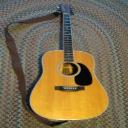Yahoo Answers is shutting down on May 4th, 2021 (Eastern Time) and beginning April 20th, 2021 (Eastern Time) the Yahoo Answers website will be in read-only mode. There will be no changes to other Yahoo properties or services, or your Yahoo account. You can find more information about the Yahoo Answers shutdown and how to download your data on this help page.
Trending News
Electric guitar help?
The action on my Les Paul is too high (the neck bows a bit), yet there is still considerable fret buzz on the bass E, A and D strings. If I adjust the tross rod, there will be more fret buzz, if I don't adjust it, my hand will die from over exertion O...o
What should I do? I've never had this problem with any of my other Gibson LPs and I'm at a loss...
@Neil, I'm fairly certain you have no idea what I'm talking about, so I'll let you off easy on the "you need a feminine guitar" sexist garbage. Peavey? Really?
I can remove the tross rod cover and I can adjust the neck. The problem is that if I drop the action, the fret buzz is still VERY present, cuz guess what? The strings are now even lower than they were before. Duh. That is the issue. Not that my Les Paul isn't genuine. It is. As are ALL my Gibsons. And the size of my fingers makes no difference cuz guess what? Les Pauls actually have a smaller scale and are in general, easier to play...
5 Answers
- 8 years agoFavorite Answer
I would like to second TommyMc's answer, as my impulse was to recommend adjustments to the bridge. Also, this may sound a bit nutty, but I bought a used LP once and the guy that had it before me was obsessed with gain and had the pickups set so high that they not only caused a bit of buzz from friction when playing with certain dynamics but also affected to intonation due to the slight magnetic pull they generate with the strings. You may want to make sure that this isn't the case in addition to the bridge. Also, I agree that at the end of the day you might want to take it to a good tech. I have been playing for over twenty years and I have never mastered some of the intricacies of setting a guitar up properly. It is a true skill and a profession unto itself.
And also, Neil. What's your problem man? Do you think the asker is a complete moron? And she is quite correct in pointing out that Les Pauls are much easier to play than many others. I used to be a Gibson man tried and true, but have been more about Fenders these days. While I still appreciate Gibson's tonal characteristics and build quality, the frets feel like a ukelele compared to a well set up Strat. Gibsons are much better suited to small hands than just about anything else out there. Sorry to burst your self-aggrandizing macho bubble, but you are wrong in trying to characterize the LP as a "man's" guitar any more than anything else on the market. And being from Mississippi, I have to ask you to please leave Peavey out of your delusion.
- TommymcLv 78 years ago
While the truss rod does affect your action, it's not the way to adjust the string height. The truss rod is used to adjust the neck relief. A properly adjusted neck will have a slight forward bow. You can't just eyeball down the neck, you need to use a straightedge. If you don't have one that's long enough, you can put a capo on the first fret, then press your bass string on the highest fret. At the halfway point between the capo and the highest fret, there should be a slight gap between the underside of the string and the top of the fret. The gap should be about the same thickness as your high E string. Tightening the truss rod will reduce the gap, loosening it will increase the gap. You turn the truss rod in small 1/4 turn increments. When you've got the gap or "relief" properly adjusted, you leave it alone, regardless of the string height.
Next, you can adjust the string height by raising or lowering the bridge. The idea is to get it as low as possible without fret buzz. Fender suggests (yes, I know you have a Gibson, but the principle is the same) setting the height between 1.6 mm and 2 mm from the top of the 17th fret to the underside of the strings. Start there and raise the bridge a little if the buzz persists.
If raising the bridge beyond a playable height doesn't get rid of the buzz, you may have worn frets or a nut that's too low. It should go without saying...but I'll say it: The best course of action is to have a guitar tech do all the work on your guitar. It's not rocket science, but if you get too aggressive with the truss rod, or start adjusting things you aren't sure of, you can mess up or even damage your guitar.
Source(s): Playing guitar since 1964 - cnewshadowLv 78 years ago
If the neck is bowing more than it should, adjust the truss rod to get rid of some of that.
Also raise the bridge slightly.
A combination of truss rod adjustment and bridge height adjustment is probably what it needs.
You didn't mention whether you got it new or used, but you've expressed a preference for vintage guitars in the past, so I'm going to presume used. (How did the pickup re-potting work out, btw?)
You should also check to make sure the nut isn't overly worn. Wound strings sliding back and forth in the slot can act like a saw blade on a nut over time, so if it is a vintage guitar with the original nut, that may be the problem (and the previous owner may have adjusted the truss rod without realizing the problem was actually the nut)
I actually like a tiny bit of fret buzz on the first few frets. Not so much that it is audible through my amp, but I like a little bit.
- ?Lv 48 years ago
Mz. Hyde, It sure ain't a genuine Gibson!
If you cannot remove a triangular plate ON
the headstock and wrench some tension on a threaded nut..
Trash the thing: Start again.
(Peavey make an incredibly feminine
'Les Paul'.. AND, I think, for smaller "Bonnie Rait" fingers, too).
- How do you think about the answers? You can sign in to vote the answer.







